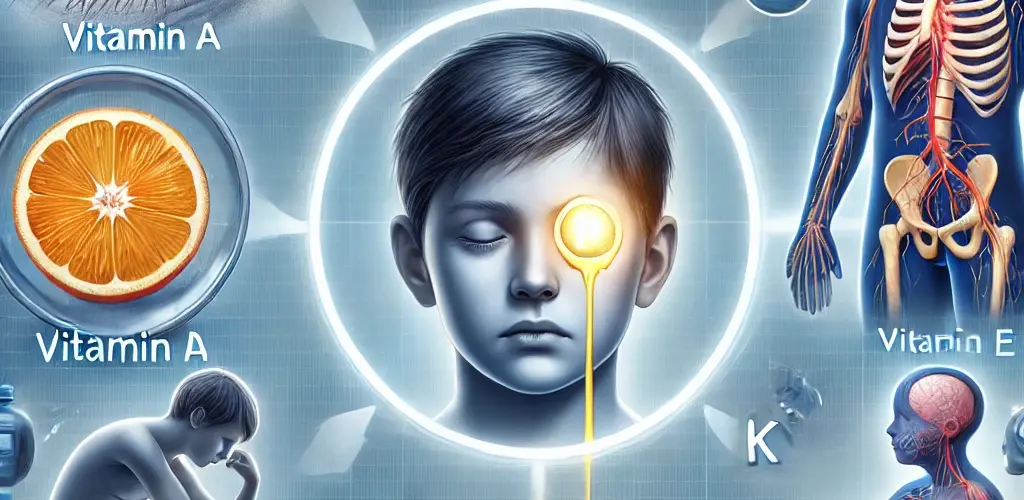Library
USMLE-Style MCQs on Fat-Soluble Vitamins | High-Yield Practice Questions
- February 21, 2025
- Posted by: Namrata Chhabra
- Category: Library Learning resources Multiple-choice questions Multiple-choice questions Multiple-Choice questions Practice questions Question Bank Question Bank QUIZZES Quizzes USMLE Content USMLE Style questions USMLE styled question bank Vitamins Vitamins and Minerals

1. A 45-year-old man presents with a history of chronic alcohol use and frequent falls. He has difficulty with balance and reduced proprioception in his lower limbs. Neurological examination reveals diminished deep tendon reflexes and a positive Romberg sign. Which fat-soluble vitamin deficiency is most likely contributing to his symptoms?
A) Vitamin A
B) Vitamin D
C) Vitamin E
D) Vitamin K
E) Vitamin B12
Correct Answer: C) Vitamin E. Vitamin E: Deficiency can lead to neurological symptoms such as ataxia, loss of proprioception, and diminished reflexes due to oxidative damage to neurons. Chronic alcohol use can exacerbate malabsorption of fat-soluble vitamins.
Incorrect options:
• Vitamin A: Deficiency primarily affects vision and epithelial health, not neurological function.
• Vitamin D: Deficiency causes bone-related issues like osteomalacia or rickets but does not lead to ataxia or proprioceptive deficits.
• Vitamin K: Deficiency leads to coagulopathy but is unrelated to neurological symptoms.
• Vitamin B12: While it can cause neurological deficits, it is not a fat-soluble vitamin.
2. A 6-month-old infant is brought to the emergency department with seizures. The child was exclusively breastfed, and the parents report no vitamin supplementation since birth. Laboratory tests reveal prolonged prothrombin time (PT) and normal calcium levels. Which vitamin deficiency is most likely responsible for this presentation?
A) Vitamin A
B) Vitamin D
C) Vitamin E
D) Vitamin K
E) Vitamin C
Correct Answer: D) Vitamin K: Newborns are at risk for vitamin K deficiency because they lack gut flora to synthesize it, leading to bleeding disorders (e.g., intracranial hemorrhage causing seizures). Breast milk is low in vitamin K, and supplementation is crucial.
Incorrect options:
• Vitamin A: Deficiency causes night blindness and keratomalacia but does not affect coagulation or cause seizures.
• Vitamin D: Deficiency leads to rickets or hypocalcemic tetany but does not prolong PT or cause bleeding.
• Vitamin E: Deficiency may cause hemolysis in infants but not coagulopathy or seizures.
• Vitamin C: Water-soluble Vitamin; deficiency leads to scurvy, not coagulopathy.
3. A 65-year-old woman with osteoporosis is started on high-dose vitamin D supplementation by her physician without monitoring serum calcium levels. Two months later, she presents with nausea, vomiting, polyuria, and confusion. What is the most likely explanation for her symptoms?
A) Hypercalcemia due to excessive vitamin D intake
B) Hypocalcemia due to inadequate calcium absorption
C) Hyperkalemia due to renal dysfunction caused by vitamin D toxicity
D) Hyperphosphatemia due to parathyroid hormone suppression by vitamin D
E) Hypophosphatemia due to increased renal phosphate excretion
Correct Answer: A) Hypercalcemia due to excessive vitamin D intake: Excessive vitamin D increases intestinal calcium absorption, leading to hypercalcemia, which manifests as nausea, vomiting, polyuria, and confusion (symptoms of hypercalcemia).
Incorrect options:
• Hypocalcemia (B): Incorrect because high-dose vitamin D increases calcium absorption rather than reducing it.
• Hyperkalemia (C): Unrelated to vitamin D toxicity; hyperkalemia is more commonly caused by renal failure or potassium retention.
• Hyperphosphatemia (D): While phosphate levels may increase with high vitamin D doses, hypercalcemia explains the clinical presentation better.
4. A researcher studying fat-soluble vitamins observes that one particular vitamin influences gene expression by binding intracellular nuclear receptors and regulating the transcription of calcium-transporting proteins in the intestine. Which Vitamin is being studied?
A) Vitamin A
B) Vitamin C
C) Vitamin D
D) Vitamin E
E) Vitamin K
Correct Answer: C) Vitamin D: Vitamin D: Acts via nuclear receptors (VDRs), regulating gene transcription for calcium homeostasis proteins like calbindin in the intestine, which is crucial for calcium absorption.
Vitamin A Also acts via nuclear receptors but primarily regulates genes involved in vision and epithelial differentiation.
5. A 32-year-old woman presents with recurrent miscarriages and a history of deep vein thrombosis (DVT). Laboratory tests reveal normal platelet count but elevated prothrombin activity levels. Which fat-soluble vitamin excess could exacerbate her hypercoagulable state?
A) Vitamin A
B) Vitamin B12
C) Vitamin C
D) Vitamin K
E) Vitamin E
Correct Answer: D) Vitamin K: Vitamin K: It plays a critical role in synthesizing clotting factors; excess can lead to increased coagulation activity, potentially exacerbating her hypercoagulable state.
Incorrect options:
• Vitamin A: Excessive intake does not significantly impact coagulation pathways.
• Vitamin B12 & C: These water-soluble vitamins do not play a direct role in coagulation.
• Vitamin E: While it has anticoagulant properties, it would not typically exacerbate a hypercoagulable state.
6. A 70-year-old woman presents with diffuse bone pain and multiple vertebral fractures. Laboratory tests show hypocalcemia, increased parathyroid hormone, and low 25-hydroxyvitamin D. What is the most likely diagnosis?
A) Hyperparathyroidism
B) Osteoarthritis
C) Osteomalacia
D) Osteoporosis
E) Paget disease
Correct Answer: C) Osteomalacia: Osteomalacia is caused by vitamin D deficiency, leading to defective bone mineralization.
Incorrect options:
• Hyperparathyroidism – Causes hypercalcemia, not hypocalcemia.
• Osteoarthritis – Joint disease, not metabolic bone disease.
• Osteoporosis – Loss of bone mass but normal mineralization.
• Paget disease – Disorganized bone remodeling with normal calcium and vitamin D levels.
7. A patient diagnosed with chronic pancreatitis presents with steatorrhea and signs of peripheral neuropathy. Which vitamin deficiency should be investigated as a potential cause of his neurological symptoms?
A) Vitamin A
B) Vitamin D
C) Vitamin K
D) Vitamin E
E) Vitamin B C
Correct Answer: D) Vitamins E:
• Vitamin E Deficiency and Neurological Symptoms: Vitamin E is an essential antioxidant that protects cell membranes from oxidative damage. Its deficiency can lead to significant neurological issues, including peripheral neuropathy, ataxia, and loss of proprioception. In chronic pancreatitis, the body’s ability to absorb fats is compromised due to insufficient pancreatic enzymes. Since vitamin E is a fat-soluble vitamin, malabsorption syndromes like chronic pancreatitis can lead to its deficiency, resulting in the neurological manifestations observed in this patient.
Incorrect options:
• Vitamin A: Vitamin A deficiency primarily affects vision (e.g., night blindness) and skin health. While it plays a role in immune function and epithelial integrity, it is not directly associated with peripheral neuropathy.
• Vitamin D: Vitamin D deficiency is primarily associated with bone health issues, such as osteomalacia in adults or rickets in children. It does not typically cause peripheral neuropathy or neurological symptoms, although it can contribute to muscle weakness.
• Vitamin K: Vitamin K is essential for blood clotting and the synthesis of certain proteins required for coagulation. Deficiency leads to bleeding disorders but does not cause neurological symptoms or peripheral neuropathy.
• Vitamin C: Vitamin C deficiency does not typically cause peripheral neuropathy or neurological symptoms.
8. A patient with Abetalipoproteinemia presents with peripheral neuropathy, spinocerebellar ataxia, skeletal muscle atrophy, and retinopathy. Which of the following vitamin deficiencies is the most likely cause?
A) Ascorbic Acid
B) Biotin
C) Cobalamine
D) Folic Acid
E) α-Tocopherol
Correct answer: E) α-Tocopherol: Peripheral neuropathy, spinocerebellar ataxia, skeletal muscle atrophy, and retinopathy in the context of Abetalipoproteinemia suggests Vitamin E (α-Tocopherol) deficiency. Abetalipoproteinemia is a defect in chylomicron and VLDL formation, leading to fat malabsorption and subsequent deficiency of fat-soluble vitamins.
Incorrect options:
• Ascorbic Acid deficiency causes scurvy
• Biotin is Vitamin B7; deficiency is rare but can cause dermatitis and neurological symptoms.
• Cobalamine is Vitamin B12; deficiency causes megaloblastic anemia and neurological symptoms
• Folic Acid is Vitamin B9; deficiency causes megaloblastic anemia.
9. A 28-year-old pregnant woman with a history of gastric bypass surgery presents at 20 weeks gestation complaining of increasing night blindness and dry eyes, alongside concerns about the developing fetus. Despite dietary counseling and supplementation, her symptoms persist. Which of the following is the most appropriate next step in managing this patient’s Vitamin A deficiency?
A) Increase oral Beta-carotene supplementation
B) Intramuscular injection of Vitamin A
C) Prescribe a higher dose of water-miscible Retinol
D) Recommend consumption of liver, to increase dietary Vitamin A intake
E) UV light therapy
Correct Answer: B) Intramuscular injection of Vitamin A: Patients with a history of gastric bypass surgery often experience fat-soluble vitamin malabsorption, including vitamin A, due to bypassing the duodenum and proximal jejunum—major sites of fat-soluble vitamin absorption. Night blindness and xerophthalmia (dry eyes) are characteristic of vitamin A deficiency, which can negatively impact both maternal and fetal health.
Since this patient’s symptoms persist despite oral supplementation, intramuscular (IM) injection of vitamin A is the most effective next step. This route bypasses intestinal absorption issues, ensuring better bioavailability and faster correction of vitamin A deficiency.
Incorrect options:
• Increase oral Beta-carotene supplementation → Incorrect. Beta-carotene must be converted into Retinol in the body, and this conversion is inefficient, especially in individuals with fat malabsorption. Thus, increasing beta-carotene intake may not significantly improve vitamin A status.
• Prescribe a higher dose of water-miscible Retinol → Incorrect.Water-miscible vitamin A formulations are better absorbed than fat-soluble forms, but severe malabsorption may still limit their effectiveness. Since this patient has persisting symptoms despite supplementation, IM injection is preferred.
• Recommend consumption of liver to increase dietary Vitamin A intake → Incorrect. The liver is a rich source of vitamin A, but due to fat malabsorption post-bypass, the patient may still be unable to absorb sufficient vitamin A from diet alone. Additionally, excess retinol intake from the liver can be teratogenic during pregnancy.
• UV light therapy → Incorrect. UV light therapy is relevant to vitamin D synthesis, not vitamin A metabolism or absorption. It has no role in treating vitamin A deficiency.
10. An elderly patient with a history of chronic kidney disease (CKD) presents with progressive muscle weakness, bone pain, and a waddling gait. Laboratory tests reveal:
• Normal serum calcium
• Elevated parathyroid hormone (PTH)
• Elevated alkaline phosphatase
• Low 24-hour urine calcium excretion
Which of the following is the most likely underlying cause?
A) Autosomal dominant hypophosphatemic rickets
B) Defective 25-hydroxylation of Vitamin D in the liver
C) Impaired 1-alpha-hydroxylation of Vitamin D in the kidney
D) Increased fibroblast growth factor 23 (FGF23) production
E) Primary hyperparathyroidism
Correct Answer: C) Impaired 1-alpha-hydroxylation of Vitamin D in the kidney
Explanation:
• Chronic kidney disease (CKD) leads to reduced 1-alpha-hydroxylase activity, impairing the conversion of 25-hydroxyvitamin D to active 1,25-dihydroxyvitamin D (calcitriol).
• Low calcitriol → Decreased calcium absorption → Secondary hyperparathyroidism (elevated PTH).
• Increased PTH causes bone resorption, leading to bone pain, muscle weakness, and elevated alkaline phosphatase.
• Low urine calcium excretion is due to PTH-mediated calcium reabsorption.
Incorrect Options:
• A) Autosomal Dominant Hypophosphatemic Rickets → Causes low phosphate, not CKD-related bone disease.
• B) Defective 25-Hydroxylation of Vitamin D in the Liver → Would cause low 25-hydroxyvitamin D, but CKD primarily affects 1-alpha-hydroxylation in the kidney.
• D) Increased Fibroblast Growth Factor 23 (FGF23) Production → FGF23 is increased in CKD but mainly causes phosphate wasting, not the primary defect in vitamin D activation.
• E) Primary Hyperparathyroidism → Would cause high calcium, whereas this patient has normal calcium with high PTH (secondary hyperparathyroidism).
